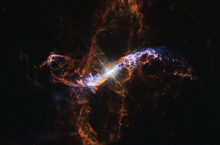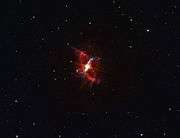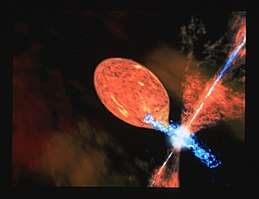R Aquarii
 | |
| Observation data Epoch J2000 Equinox J2000 | |
|---|---|
| Constellation | Aquarius |
| Right ascension | 23h 43m 49.46201s[1] |
| Declination | −15° 17′ 04.1385″[1] |
| Apparent magnitude (V) | 5.2 - 12.4[2] |
| Characteristics | |
| Spectral type | M5e-M8.5e + pec[2] |
| U−B color index | −0.62[3] |
| B−V color index | +1.98[3] |
| Variable type | Mira + Z And[2] |
| Astrometry | |
| Radial velocity (Rv) | -22.0[4] km/s |
| Proper motion (μ) | RA: +37.13 ± 0.47[5] mas/yr Dec.: −28.62 ± 0.44[5] mas/yr |
| Parallax (π) | 4.59 ± 0.24[5] mas |
| Distance | 710 ± 40 ly (220 ± 10 pc) |
| Orbit[6] | |
| Period (P) | 15,943 ± 471 |
| Semi-major axis (a) | 0.071 - 0.084" (14.2 - 16.8 AU) |
| Eccentricity (e) | 0.25 ± 0.07 |
| Inclination (i) | 70° |
| Details | |
| A | |
| Mass | 1 - 1.5[6] M☉ |
| Radius | 430[6] R☉ |
| Luminosity | 4,780[7] L☉ |
| Surface gravity (log g) | −0.5[7] cgs |
| Temperature | 2,800[7] K |
| B | |
| Mass | 0.6 - 1[6] M☉ |
| Other designations | |
| Database references | |
| SIMBAD | data |
| Data sources: | |
| Hipparcos Catalogue, CCDM (2002), Bright Star Catalogue (5th rev. ed.) | |

R Aquarii (R Aqr) is a variable star in the constellation Aquarius.[8]
R Aquarii is a symbiotic star believed to contain a white dwarf and a Mira-type variable in a binary system. The orbital period is approximately 44 years.[6] The main Mira-type star is a red giant, and varies in brightness by a factor of several hundred and with a period of slightly more than a year; this variability was discovered by Karl Ludwig Harding in 1810. It has a distance of about 200 parsec, and is one of the nearest symbiotic stars and a well known jet source.[9] The two components have been resolved at a separation of 55 mas.[10]
By its gravitational pull, the white dwarf draws in material from the red giant and occasionally ejects some of the surplus in weird loops to form the nebula seen in the linked image.[11] The whole system appears reddened because it is situated in a very dusty region of space, and its blue light is absorbed before reaching Earth.
The nebula around R Aquarii is also known as Cederblad 211.[12] It is possible that the nebula is the remnant of a nova-like outburst, which may have been observed by Japanese astronomers, in the year 930 AD.[13] It is reasonably bright but small and dominated by its central star. Visual observations are difficult and rare.[14] The central region of the jet shows an ejection that took place around 190 years ago, as well as much younger structures.[15]
The giant primary star is a Mira variable, a star that pulsates and changes temperature, leading to very large visual brightness changes. The total range of 5.2 - 12.4 is a variation of 750 times in brightness, from a naked eye star to one beyond the range of binoculars. The pulsations occur every 390 days but are not entirely regular.[2]



References
- 1 2 Van Leeuwen, F. (2007). "Validation of the new Hipparcos reduction". Astronomy and Astrophysics. 474 (2): 653. arXiv:0708.1752. Bibcode:2007A&A...474..653V. doi:10.1051/0004-6361:20078357.
- 1 2 3 4 Samus, N. N.; Durlevich, O. V.; et al. (2009). "VizieR Online Data Catalog: General Catalogue of Variable Stars (Samus+ 2007-2013)". VizieR On-line Data Catalog: B/gcvs. Originally published in: 2009yCat....102025S. 1. Bibcode:2009yCat....102025S.
- 1 2 Celis s., L. (1982). "Red variable stars. I - UBVRI photometry and photometric properties". Astronomical Journal. 87: 1791. Bibcode:1982AJ.....87.1791C. doi:10.1086/113268.
- ↑ Wilson, Ralph Elmer (1953). "General catalogue of stellar radial velocities". Washington. Bibcode:1953GCRV..C......0W.
- 1 2 3 Min, Cheulhong; Matsumoto, Naoko; Kim, Mi Kyoung; Hirota, Tomoya; Shibata, Katsunori M.; Cho, Se-Hyung; Shizugami, Makoto; Honma, Mareki (2014). "Accurate parallax measurement toward the symbiotic star R Aquarii". Publications of the Astronomical Society of Japan. 66 (2): 38. arXiv:1401.5574. Bibcode:2014PASJ...66...38M. doi:10.1093/pasj/psu003.
- 1 2 3 4 5 M. Gromadzki & J. Mikołajewska (March 2009). "The spectroscopic orbit and the geometry of R Aquarii". Astronomy & Astrophysics. 495 (3): 931–936. arXiv:0804.4139. Bibcode:2009A&A...495..931G. doi:10.1051/0004-6361:200810052.
- 1 2 3 Mayer, A.; Jorissen, A.; Kerschbaum, F.; Ottensamer, R.; Nowotny, W.; Cox, N. L. J.; Aringer, B.; Blommaert, J. A. D. L.; Decin, L.; Van Eck, S.; Gail, H.-P.; Groenewegen, M. A. T.; Kornfeld, K.; Mecina, M.; Posch, Thomas; Vandenbussche, B.; Waelkens, C. (2013). "Large-scale environments of binary AGB stars probed by Herschel. I. Morphology statistics and case studies of R Aquarii and W Aquilae". Astronomy & Astrophysics. 549: A69. arXiv:1211.3595. Bibcode:2013A&A...549A..69M. doi:10.1051/0004-6361/201219259.
- ↑ "R Aquarii | aavso.org". www.aavso.org. Retrieved 2018-07-11.
- ↑ Stute, Matthias; Sahai, Raghvendra. "Hydrodynamical Simulations of the Jet in the Symbiotic Star MWC 560". The Astrophysical Journal. The American Astronomical Society. Retrieved 10 October 2011.
- ↑ Hollis, J. M.; Pedelty, J. A.; Lyon, R. G. (1997). "Spatial Resolution of the R Aquarii Binary System". The Astrophysical Journal. 482: L85. Bibcode:1997ApJ...482L..85H. doi:10.1086/310687.
- ↑ "Aladin previewer". CDS.
- ↑ Cederblad, S (1946). "Studies of bright diffuse galactic nebulae with special regard to their spatial distribution". Lund Medd. Astron. Obs. Ser. II. 119: 1. Bibcode:1946MeLuS.119....1C.
- ↑ Kafatos, Minas; Michalitsianos, Andrew G (1982). "The peculiar variable star R Aquarii and its jet". Nature. 298 (5874): 540. Bibcode:1982Natur.298..540K. doi:10.1038/298540a0.
- ↑ "The Drama-Ridden Couple of R Aquarii". Sky & Telescope. Retrieved 2018-01-18.
- ↑ Paresce, Francesco; Hack, Warren (1994). "New HST observations of the core of R Aquarii. 1: Imaging". Astronomy and Astrophysics (ISSN 0004-6361). 287: 154. Bibcode:1994A&A...287..154P.
External links
- Weird loop image in R Aquarii
- R Aquarii on WikiSky: DSS2, SDSS, GALEX, IRAS, Hydrogen α, X-Ray, Astrophoto, Sky Map, Articles and images
- NASA Astronomy Picture of the Day: Symbiotic Star System R Aquarii (4 January 1996)
- AAVSO Variable Star of the Month. R Aquarii: Summer 2003
- R Aquarii (Cederblad 211) Visual observation of a symbiotic star